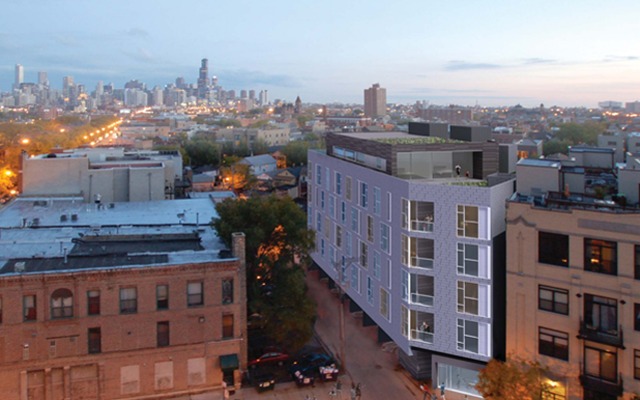Less Parking, More Bike Racks Under Mayor's TOD Ordinance Expansion
By Rachel Cromidas in News on Jul 30, 2015 1:20PM
if you build it, will they bike?
That question is at the crux of a new proposal to dramatically loosen the rules on where developers can build new apartments without parking spots. Mayor Rahm Emanuel said he hopes an update to the city's Transit-Oriented Development Ordinance will be a win-win for real estate developers, businesses and everyone who uses the streets.
As the logic goes, create 'parking lite' apartment buildings—a.k.a. TODs—where residents must bike or use public transportation to get around because there are few private parking spots to be found, and the streets will be safer, traffic will be calmed and local businesses will thrive. So far eight TOD real estate projects have taken advantage of the ordinance since it was approved in 2013.
The TOD ordinance has since found its fans and its detractors. Some believe it goes too far, allowing real estate developers to charge more for less space and force already cramped communities to compete for what little on-street parking is around. The city typically requires residential buildings to offer one parking space per housing unit, but the ordinance cuts that requirement in half. Others have said it doesn't go far enough.
City Hall is now looking to make the ordinance, which creates a special zone within 600 or 1,200 feet of a CTA station where developers can propose their low-on-parking residences, go farther, the mayor's office announced this week.
The reform would extend the zone for TODs to plots of land within 1,360 feet of a transit station, more than double the current distance, or within 2,640 feet on streets with lots of foot traffic and retail outlets—up from 1,200 feet now. Developers looking to build new homes on those plots of land wouldn't need to provide any off-street parking under the mayor's reforms, as long as they make bike parking available to everyone who lives there.
"Over the last four years, we have invested in our public transportation system to create jobs and revitalize commercial corridors across Chicago," Emanuel said in a statement. "This ordinance will capitalize these investments by accelerating development near transit stations."
If this move doesn't solidify Emanuel's reputation as the "bike mayor," and Chicago's spot on the list of the nation's most "bike-friendly" cities, nothing will.
Many TOD advocates, including the heads of the Metropolitan Planning Council, say the new ordinance could have far-reaching positive benefits on the city. Think: reducing congestion, improving public transportation and the city's bike lanes, countering population loss and sweetening the deal for cash-strapped developers. Still, with its strict zoning requirements, the ordinance has so far hardly proven itself to be a panacea for a 21st century city's woes, and the majority of TOD plans thus far have been concentrated on the Northwest Side off the Blue Line.
The council will likely vote on the legislation in September, according to Streetsblog.
